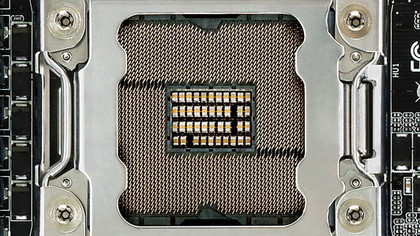Why you can trust TechRadar
The new Intel Xeon 2687W may not be targeted directly at the desktop, but it will drop straight into any Intel X79-based PC motherboard with the LGA2011 socket and fire up like a trooper.
If you can afford the asking price, therefore, it is an option for a desktop PC.
Like the Intel Core i7 3960X, this new Xeon benefits from Intel's Sandy Bridge microarchitecture. As it happens, Sandy Bridge is expected to be superseded by the introduction of Ivy Bridge in just a few weeks. But Ivy Bridge will initially be aimed at more mainstream systems via the LGA 1155 socket.
For at least the next six months, Sandy Bridge will remain the engine powering Intel's very fastest processors until we see the Ivy Bridge E variants tipping up towards the end of the year.

Anyway, that makes the Intel Xeon 2687W a 32nm beast with no fewer than four memory channels.
It also means the 2687W doesn't get Intel's integrated HD Graphics and in turn misses out on QuickSync video transcoding.
Apart from the enabling of the final two cores inside the Sandy Bridge E die, where the 2687W chiefly differs from its Core i7 sibling is cache and clockspeed.
It's ever so slightly slower at 3.1GHz to the Core i7's 3.3GHz.
Nope, it's not a dramatic difference and it's a lot less than we were expecting after Intel told us it had disabled the final two cores in the Core i7 3960X because that made for the best balance between clockspeed and cores.
Turns out, you can have all the cores enabled without winding down the frequency significantly.
As for cache, it's 20MB plays 15MB, again in the Xeon's favour. The only other difference of note involves overclocking.
Put simply, you can't overclock the Xeon 2687W.
The multipliers are locked and the baseclock just won't tolerate more than a percentage point or two of tweaking. As we'll see, that's a serious blow to the Xeon's enthusiast credentials, but not unexpected from a chip designed for stability in a workstation environment.
But first, what about performance at stock clocks?
Well, the Xeon is quicker across the board, making it by far the fastest processor we've ever tested.
OK, it's not the full 33 per cent faster in multi-threaded software you might postulate from the transition from six to eight cores. But it's not a million miles away in several benchmarks, including professional rendering, video encoding and database crunching.
It's also barely any slower in single-threaded software, which isn't a huge surprise given the similar clockspeeds.
That said, there's not much evidence the extra cache memory has an impact on the desktop.
Of course, with this extra performance comes greater power consumption to the tune of an extra 40 watts under load. But much more of a problem is that overclocking limitation.
Crank a Core i7 3960X up to 4.5GHz and it delivers near identical performance to the Xeon 2687W, but for half the price.
Whoops.
We liked
"Comfortably the fastest processor we've ever tested."
Eight cores is what the Sandy Bridge E die has. Once you've paid for it, eight cores is what you should get. And that's exactly what the Intel Xeon 2687W gives you.
The result is comfortably the fastest processor we've ever tested.
It's also a drop-in upgrade for any X79. Yippee.
We disliked
The workstation and server market is a different world from that of the desktop PC.
The enormous price of the Intel Xeon 2687W may make sense in the former, but it's far too rich for the latter, especially when you consider the lack of overclocking support.
Final word
By turning cores on but turning overclocking off, this eight-core Xeon is a zero sum game.
As expected it's just not cost effective on the desktop, but still puts into question why exactly we don't have a full eight-core desktop processor in the desktop Sandy Bridge E family.
One thing's for certain; it's not a technical limitation.
Technology and cars. Increasingly the twain shall meet. Which is handy, because Jeremy (Twitter) is addicted to both. Long-time tech journalist, former editor of iCar magazine and incumbent car guru for T3 magazine, Jeremy reckons in-car technology is about to go thermonuclear. No, not exploding cars. That would be silly. And dangerous. But rather an explosive period of unprecedented innovation. Enjoy the ride.
